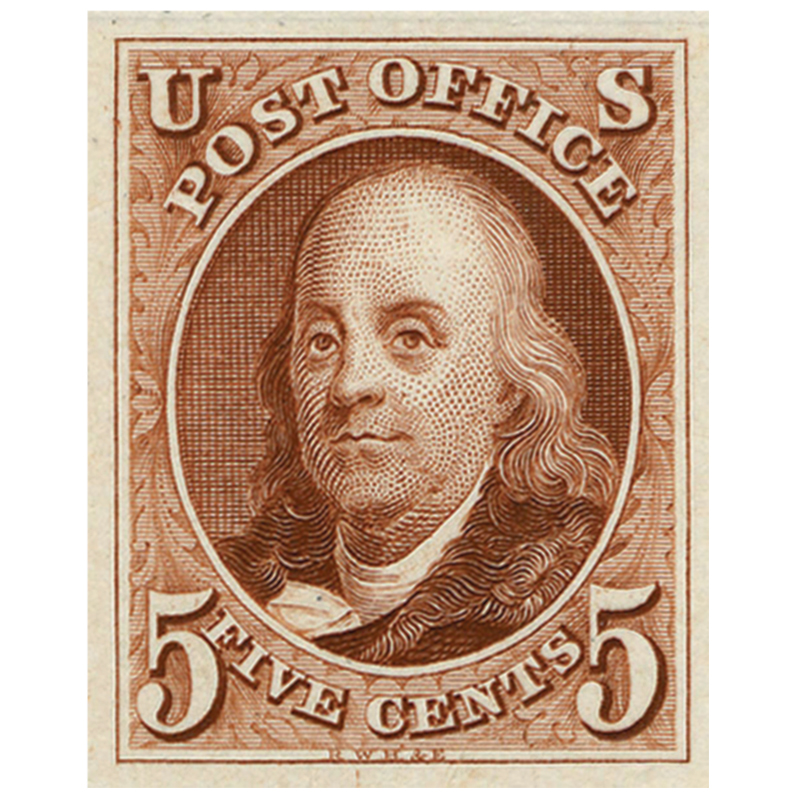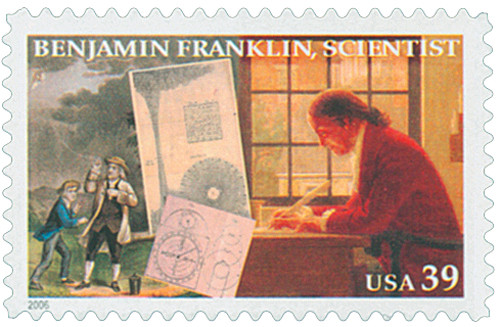
# 4021-24 FDC - 2006 39c Benjamin Franklin
2006 39¢ Benjamin Franklin
City: Philadelphia, PA
Quantity: 40,000,000
Please note: Due to the layout of the pane, the se-tenant may or may not be provided in Scott Catalogue order.
Happy Birthday Benjamin Franklin
Franklin was the son of a soap and candle maker. As a youth, he learned these trades but found them unsatisfactory. So he became an apprentice to his brother James, a printer, at the age of 12. It was in this apprenticeship that Franklin started what he considered his primary, lifelong occupation – printing.
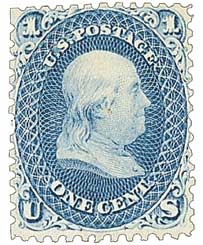
During this time Franklin also wrote many articles that were submitted and published under the pseudonym “Silence Dogood.” These writings demonstrated his unique wit, humor, and insight. However, when his brother discovered that Benjamin was the author of the articles, he refused to publish them. The two brothers quarreled frequently, and at the age of 17, Franklin ran away and settled in Philadelphia, Pennsylvania.
Franklin’s arrival in Philadelphia has become a classic part of American folklore. The young man arrived in the city on a Sunday morning, tired and hungry. At a bakery, he asked for three pennies’ worth of bread, and received three loaves. He then bravely walked up Market Street with a loaf under each arm while eating the third. As he passed the door of the Read family, his future wife, Deborah Read, watched him walk by, and thought he made “a most awkward and ridiculous appearance.”
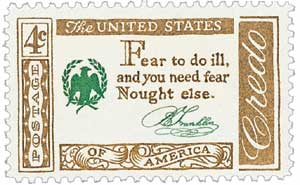
From 1723-1730, Franklin worked for several printers in Philadelphia and in London, England. In 1728, at the age of 22, he was able to become a partner in a print shop. Just two years later, he became the sole owner. Franklin published The Pennsylvania Gazette from 1729 to 1766, and wrote nearly all of the paper’s content. It became one of the most famous newspapers in the colonies. Historians credit Franklin as the first newspaper editor to publish a cartoon and to include a map with a story – everyday practices in modern newspapers.
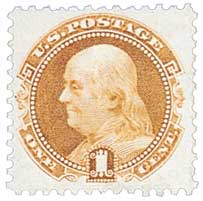
From 1733 to 1758, Franklin published Poor Richard’s Almanac. He wrote the almanac under the name of Richard Saunders, an imaginary astronomer. Poor Richard’s Almanac included astrological information, jokes, poems, and weather predictions. One of the greatest features of the almanac was Richard’s proverbs, which reflected Franklin’s philosophies of thrift, hard work, and simple living. One of these sayings is featured on the Franklin “Credo” stamp above.
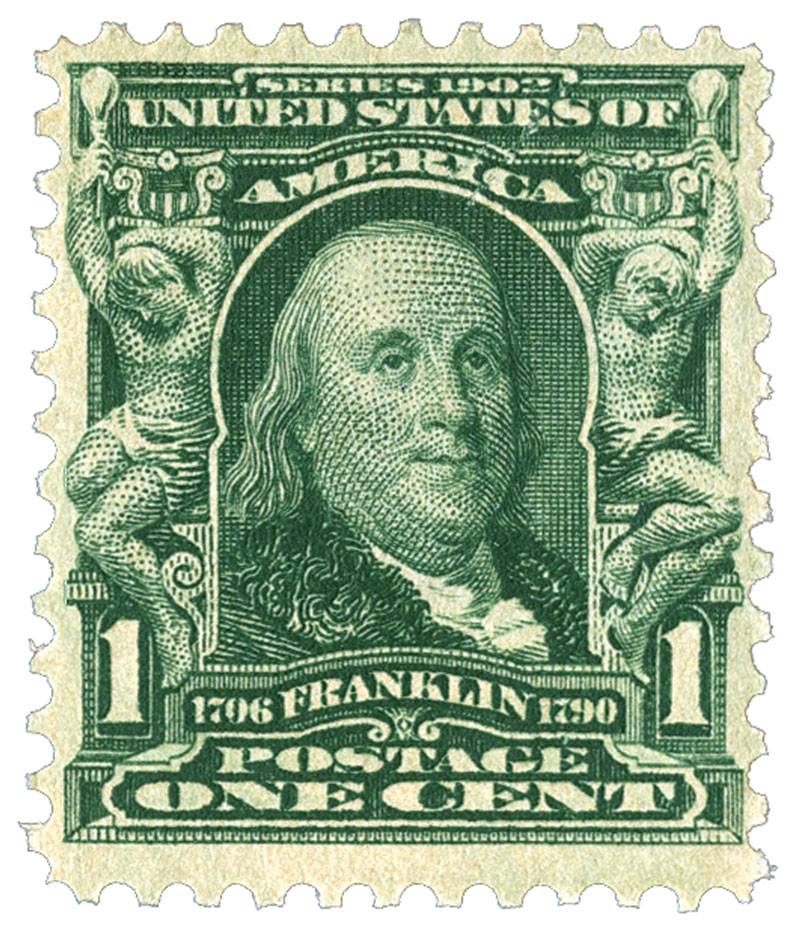
Aside from his publishing work, Franklin flourished, and his accomplishments and contributions to the city earned him the title “The first citizen of Philadelphia.” Franklin’s many contributions to the city of Philadelphia include: founding the first subscription library in the American colonies; organizing the city’s fire department; law enforcement reform; leading efforts to pave, clean, and light public streets; raising money to build a city hospital, the Pennsylvania Hospital; and founding the academy that became the University of Pennsylvania. Franklin was also an important inventor and scientist. He discovered lightning was electricity, and created such terms as armature, condenser, and battery.
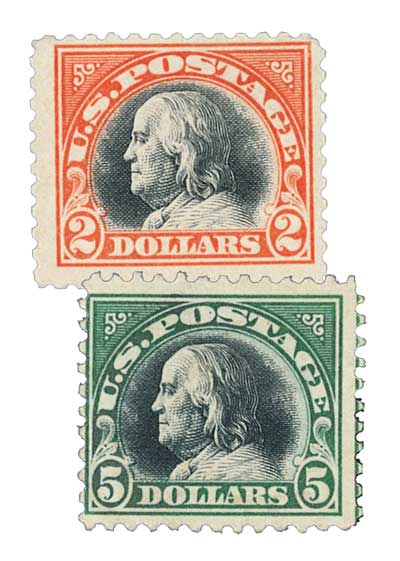
In 1753, Franklin was appointed deputy postmaster general of the American colonies. He greatly improved the frequency and reliability of mail service. By 1761, the post office showed a profit for the very first time. Under Franklin’s supervision, the Colonial post office continued to show a profit for several years. In 1774, Franklin was dismissed from the office due to his views on Britain’s “taxation without representation.”
In 1775, when the American Revolution began, Franklin was the obvious choice for starting the new mail system, and the Continental Congress appointed him the first postmaster general of the United States. Soon, mail was flowing from Portland, Maine, to Savannah, Georgia. Franklin standardized rates, surveyed routes, erected milestones along long-distance delivery routes, and slashed delivery time between major cities by half. Franklin donated his salary for relief for wounded soldiers.
As the war progressed, it quickly became obvious that an alliance with France could ultimately decide the outcome of the Revolution. Late in 1776, at the age of 70, Franklin traveled to France to secure an alliance. He received a hero’s welcome in Paris. The French appreciated Franklin’s kindness and wisdom, but were hesitant to enter a war against the British. However, Franklin remained persistent. After the British surrender at Saratoga, the French were sufficiently impressed. On February 6, 1778, the French signed a pact with the United States. Franklin immediately arranged for transportation of French officers, soldiers, and guns to America. He remained in Paris and kept generous gifts and loans from France flowing to America. Historians believe that without France’s assistance, the United States would have lost the war.

Franklin was the only person to sign all four of the key documents in United States history: the Declaration of Independence, the Treaty of Alliance with France, the Treaty of Paris with Great Britain, and the Constitution of the United States. He died on April 17, 1790. As a statesman, he stands among the top rank of the people who built our nation.
2006 39¢ Benjamin Franklin
City: Philadelphia, PA
Quantity: 40,000,000
Please note: Due to the layout of the pane, the se-tenant may or may not be provided in Scott Catalogue order.
Happy Birthday Benjamin Franklin
Franklin was the son of a soap and candle maker. As a youth, he learned these trades but found them unsatisfactory. So he became an apprentice to his brother James, a printer, at the age of 12. It was in this apprenticeship that Franklin started what he considered his primary, lifelong occupation – printing.

During this time Franklin also wrote many articles that were submitted and published under the pseudonym “Silence Dogood.” These writings demonstrated his unique wit, humor, and insight. However, when his brother discovered that Benjamin was the author of the articles, he refused to publish them. The two brothers quarreled frequently, and at the age of 17, Franklin ran away and settled in Philadelphia, Pennsylvania.
Franklin’s arrival in Philadelphia has become a classic part of American folklore. The young man arrived in the city on a Sunday morning, tired and hungry. At a bakery, he asked for three pennies’ worth of bread, and received three loaves. He then bravely walked up Market Street with a loaf under each arm while eating the third. As he passed the door of the Read family, his future wife, Deborah Read, watched him walk by, and thought he made “a most awkward and ridiculous appearance.”

From 1723-1730, Franklin worked for several printers in Philadelphia and in London, England. In 1728, at the age of 22, he was able to become a partner in a print shop. Just two years later, he became the sole owner. Franklin published The Pennsylvania Gazette from 1729 to 1766, and wrote nearly all of the paper’s content. It became one of the most famous newspapers in the colonies. Historians credit Franklin as the first newspaper editor to publish a cartoon and to include a map with a story – everyday practices in modern newspapers.

From 1733 to 1758, Franklin published Poor Richard’s Almanac. He wrote the almanac under the name of Richard Saunders, an imaginary astronomer. Poor Richard’s Almanac included astrological information, jokes, poems, and weather predictions. One of the greatest features of the almanac was Richard’s proverbs, which reflected Franklin’s philosophies of thrift, hard work, and simple living. One of these sayings is featured on the Franklin “Credo” stamp above.

Aside from his publishing work, Franklin flourished, and his accomplishments and contributions to the city earned him the title “The first citizen of Philadelphia.” Franklin’s many contributions to the city of Philadelphia include: founding the first subscription library in the American colonies; organizing the city’s fire department; law enforcement reform; leading efforts to pave, clean, and light public streets; raising money to build a city hospital, the Pennsylvania Hospital; and founding the academy that became the University of Pennsylvania. Franklin was also an important inventor and scientist. He discovered lightning was electricity, and created such terms as armature, condenser, and battery.

In 1753, Franklin was appointed deputy postmaster general of the American colonies. He greatly improved the frequency and reliability of mail service. By 1761, the post office showed a profit for the very first time. Under Franklin’s supervision, the Colonial post office continued to show a profit for several years. In 1774, Franklin was dismissed from the office due to his views on Britain’s “taxation without representation.”
In 1775, when the American Revolution began, Franklin was the obvious choice for starting the new mail system, and the Continental Congress appointed him the first postmaster general of the United States. Soon, mail was flowing from Portland, Maine, to Savannah, Georgia. Franklin standardized rates, surveyed routes, erected milestones along long-distance delivery routes, and slashed delivery time between major cities by half. Franklin donated his salary for relief for wounded soldiers.
As the war progressed, it quickly became obvious that an alliance with France could ultimately decide the outcome of the Revolution. Late in 1776, at the age of 70, Franklin traveled to France to secure an alliance. He received a hero’s welcome in Paris. The French appreciated Franklin’s kindness and wisdom, but were hesitant to enter a war against the British. However, Franklin remained persistent. After the British surrender at Saratoga, the French were sufficiently impressed. On February 6, 1778, the French signed a pact with the United States. Franklin immediately arranged for transportation of French officers, soldiers, and guns to America. He remained in Paris and kept generous gifts and loans from France flowing to America. Historians believe that without France’s assistance, the United States would have lost the war.

Franklin was the only person to sign all four of the key documents in United States history: the Declaration of Independence, the Treaty of Alliance with France, the Treaty of Paris with Great Britain, and the Constitution of the United States. He died on April 17, 1790. As a statesman, he stands among the top rank of the people who built our nation.







